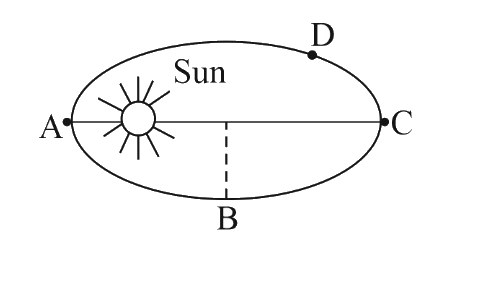A planet is revolving round the sun is elliptical orbit. Velocity at perigee position ( nearest) is and at apogee position ( farthest) is . Both these velocities are perpendicular to the line joining centre of sun and planet. is the minimum distance and the maximum distance.
When the planet is at perigee position, it wants to revolve in a circular orbit by itselff. For this, value of G
a.should increase
b.should decrease
c. will not depends on the value of G
d. data is insufficient
The correct Answer is:A
To solve the problem, we need to analyze the conditions under which a planet, at its perigee position, can maintain a circular orbit around the Sun.
1. Understanding the Problem:
- The planet is in an elliptical orbit around the Sun.
- At perigee (the closest point), the velocity is v1.
- At apogee (the farthest point), the velocity is v2.
- We need to determine the value of gravitational constant G when the planet at perigee wants to revolve in a circular orbit.
2. Orbital Velocity Formula:
- The orbital velocity v0 for a circular orbit is given by:
v0=√GMR
- Here, G is the gravitational constant, M is the mass of the Sun, and R is the radius of the orbit.
3. Condition for Circular Orbit:
- For the planet to maintain a circular orbit at perigee, its velocity v1 must equal the circular orbital velocity v0:
v1=v0
4. Substituting the Orbital Velocity:
- From the above condition, we can write:
v1=√GMr1
- Where r1 is the distance from the Sun to the planet at perigee.
5. Setting Up the Equation:
- To maintain a circular orbit, we need:
v1=√GMr1⟹v21=GMr1
6. Finding the Expression for G:
- Rearranging the equation gives us:
G=v21r1M
7. Conclusion:
- Since v1 is greater than v2 (the velocity at apogee), and for the planet to revolve in a circular orbit at perigee, G must be sufficient to ensure that the velocity v1 can be achieved. Therefore, if v1 is greater than the required orbital velocity, G must increase to maintain this condition.
Final Answer:
- The value of G must increase for the planet at perigee to revolve in a circular orbit.
- The planet is in an elliptical orbit around the Sun.
- At perigee (the closest point), the velocity is v1.
- At apogee (the farthest point), the velocity is v2.
- We need to determine the value of gravitational constant G when the planet at perigee wants to revolve in a circular orbit.
- The orbital velocity v0 for a circular orbit is given by:
v0=√GMR
- Here, G is the gravitational constant, M is the mass of the Sun, and R is the radius of the orbit.
- For the planet to maintain a circular orbit at perigee, its velocity v1 must equal the circular orbital velocity v0:
v1=v0
- From the above condition, we can write:
v1=√GMr1
- Where r1 is the distance from the Sun to the planet at perigee.
- To maintain a circular orbit, we need:
v1=√GMr1⟹v21=GMr1
- Rearranging the equation gives us:
G=v21r1M
- Since v1 is greater than v2 (the velocity at apogee), and for the planet to revolve in a circular orbit at perigee, G must be sufficient to ensure that the velocity v1 can be achieved. Therefore, if v1 is greater than the required orbital velocity, G must increase to maintain this condition.
- The value of G must increase for the planet at perigee to revolve in a circular orbit.
Topper's Solved these Questions
Similar Questions
A planet is revolving round the sun is elliptical orbit. Velocity at perigee position ( nearest) is v1 and at apogee position ( farthest) is v2. Both these velocities are perpendicular to the line joining centre of sun and planet. r1 is the minimum distance and r2 the maximum distance.
At apogee position suppose speed of planet is slightly decreased from v2, then what will happen to minimum distance r1 and maximum distance r2 in the subsequent motion.
View SolutionA planet is revolving around the sun as shown in elliptical path. The correct option is

View SolutionIn elliptical orbit of a planet
View SolutionA planet is revolving round the sun in an elliptical orbit as shown in figure. Select correct alternative(s)
View SolutionA planet is moving round the sun in an elliptical orbit as shows. As the planet moves from A to B

View SolutionFor a planet revolving around Sun in an elliptical orbit, to obtain its velocity at any point we have to apply
View SolutionA planet is revolving round the sun in an elliptical orbit, If v is the velocity of the planet when its position vector from the sun is r, then areal velocity of the planet is
View SolutionA planet revolves around the sun in an elliptical . The linear speed of the planet will be maximum at

View SolutionWhich planet is farthest to Sun ?
View SolutionA planet is revolving around the sun in an elliptcal orbit. Its KE is different for different points and the total energy is negative. Its linear momentum is not conserved the eccentricity decides the shape of the orbit.

Linear momentum of the planet is
View Solution
